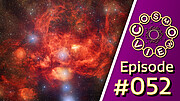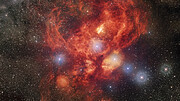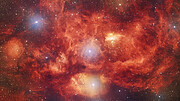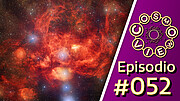“We made so many discoveries, we have changed the view of our Galaxy forever,” says Dante Minniti, an astrophysicist at Universidad Andrés Bello in Chile who led the overall project.
This record-breaking map comprises 200 000 images taken by ESO’s VISTA ― the Visible and Infrared Survey Telescope for Astronomy. Located at ESO’s Paranal Observatory in Chile, the telescope’s main purpose is to map large areas of the sky. The team used VISTA’s infrared camera VIRCAM, which can peer through the dust and gas that permeates our galaxy. It is therefore able to see the radiation from the Milky Way’s most hidden places, opening a unique window onto our galactic surroundings.
This gigantic dataset [1] covers an area of the sky equivalent to 8600 full moons, and contains about 10 times more objects than a previous map released by the same team back in 2012. It includes newborn stars, which are often embedded in dusty cocoons, and globular clusters –– dense groups of millions of the oldest stars in the Milky Way. Observing infrared light means VISTA can also spot very cold objects, which glow at these wavelengths, like brown dwarfs (‘failed’ stars that do not have sustained nuclear fusion) or free-floating planets that don’t orbit a star.
The observations began in 2010 and ended in the first half of 2023, spanning a total of 420 nights. By observing each patch of the sky many times, the team was able to not only determine the locations of these objects, but also track how they move and whether their brightness changes. They charted stars whose luminosity changes periodically that can be used as cosmic rulers for measuring distances [2]. This has given us an accurate 3D view of the inner regions of the Milky Way, which were previously hidden by dust. The researchers also tracked hypervelocity stars — fast-moving stars catapulted from the central region of the Milky Way after a close encounter with the supermassive black hole lurking there.
The new map contains data gathered as part of the VISTA Variables in the Vía Láctea (VVV) survey [3] and its companion project, the VVV eXtended (VVVX) survey. “The project was a monumental effort, made possible because we were surrounded by a great team,” says Roberto Saito, an astrophysicist at the Universidade Federal de Santa Catarina in Brazil and lead author of the paper published today in Astronomy & Astrophysics on the completion of the project.
The VVV and VVVX surveys have already led to more than 300 scientific articles. With the surveys now complete, the scientific exploration of the gathered data will continue for decades to come. Meanwhile, ESO’s Paranal Observatory is being prepared for the future: VISTA will be updated with its new instrument 4MOST and ESO's Very Large Telescope (VLT) will receive its MOONS instrument. Together, they will provide spectra of millions of the objects surveyed here, with countless discoveries to be expected.
Notes
[2] One way to measure the distance to a star is by comparing how bright it appears as seen from Earth to how intrinsically bright it is; but the latter is often unknown. Certain types of stars change their brightness periodically, and there is a very strong connection between how quickly they do this and how intrinsically luminous they are. Measuring these fluctuations allows astronomers to work out how luminous these stars are, and therefore how far away they lie.
[3] Vía Láctea is the Latin name for the Milky Way.
More information
The team is composed of R. K. Saito (Departamento de Física, Universidade Federal de Santa Catarina, Florianópolis, Brazil [UFSC]), M. Hempel (Instituto de Astrofísica, Dep. de Ciencias Físicas, Facultad de Ciencias Exactas, Universidad Andres Bello, Providencia, Chile [ASTROUNAB] and Max Planck Institute for Astronomy, Heidelberg, Germany), J. Alonso-García (Centro de Astronomía, Universidad de Antofagasta, Antofagasta, Chile [CITEVA] and Millennium Institute of Astrophysics, Providencia, Chile [MAS]), P. W. Lucas (Centre for Astrophysics Research, University of Hertfordshire, Hatfield, United Kingdom [CAR]), D. Minniti (ASTROUNAB; Vatican Observatory, Vatican City, Vatican City State [VO] and UFSC), S. Alonso (Departamento de Geofísica y Astronomía, CONICET, Facultad de Ciencias Exactas, Físicas y Naturales, Universidad Nacional de San Juan, Rivadavia, Argentina [UNSJ-CONICET]), L. Baravalle (Instituto de Astronomía Teórica y Experimental, Córdoba, Argentina [IATE-CONICET]; Observatorio Astronómico de Córdoba, Universidad Nacional de Córdoba, Argentina [OAC]), J. Borissova (Instituto de Física y Astronomía, Universidad de Valparaíso, Valparaíso, Chile [IFA-UV] and MAS), C. Caceres (ASTROUNAB), A. N. Chené (Gemini Observatory, Northern Operations Center, Hilo, USA), N. J. G. Cross (Wide-Field Astronomy Unit, Institute for Astronomy, University of Edinburgh, Royal Observatory, Edinburgh, United Kingdom), F. Duplancic (UNSJ-CONICET), E. R. Garro (European Southern Observatory, Vitacura, Chile [ESO Chile]), M. Gómez (ASTROUNAB), V. D. Ivanov (European Southern Observatory, Garching bei München [ESO Germany]), R. Kurtev (IFA-UV and MAS), A. Luna (INAF – Osservatorio Astronomico di Capodimonte, Napoli, Italy [INAF- OACN]), D. Majaess (Mount Saint Vincent University, Halifax, Canada), M. G. Navarro (INAF – Osservatorio Astronomico di Roma, Italy [INAF-OAR]), J. B. Pullen (ASTROUNAB), M. Rejkuba (ESO Germany), J. L. Sanders (Department of Physics and Astronomy, University College London, London, United Kingdom), L. C. Smith (Institute of Astronomy, University of Cambridge, Cambridge, United Kingdom), P. H. C. Albino (UFSC), M. V. Alonso (IATE-CONICET and OAC), E. B. Amôres (Departamento de Física, Universidade Estadual de Feira de Santana, Feira de Santana, Brazil), E. B. R. Angeloni (Gemini Observatory/NSF’s NOIRLab, La Serena, Chile [NOIRLab]), J. I. Arias (Departamento de Astronomía, Universidad de La Serena, La Serena, Chile [ULS]), M. Arnaboldi (ESO Germany), B. Barbuy (Universidade de São Paulo, São Paulo, Brazil), A. Bayo (ESO Germany), J. C. Beamin (ASTROUNAB and Fundación Chilena de Astronomía, Santiago, Chile), L. R. Bedin (Istituto Nazionale di Astrofisica, Osservatorio Astronomico di Padova, Padova, Italy [INAF-OAPd]), A. Bellini (Space Telescope Science Institute, Baltimore, USA [STScI]), R. A. Benjamin (Department of Physics, University of Wisconsin-Whitewater, Whitewater, USA), E. Bica (Departamento de Astronomia, Instituto de Física, Porto Alegre, Brazil [IF – UFRGS]), C. J. Bonatto (IF – UFRGS), E. Botan (Instituto de Ciências Naturais, Humanas e Sociais, Universidade Federal de Mato Grosso, Sinop, Brazil), V. F. Braga (INAF-OAR), D. A. Brown (Vatican Observatory, Tucson, USA), J. B. Cabral (IATE-CONICET and Gerencia De Vinculación Tecnológica, Comisión Nacional de Actividades Espaciales, Córdoba, Argentina), D. Camargo (Colégio Militar de Porto Alegre, Ministério da Defesa, Exército Brasileiro, Brazil), A. Caratti o Garatti (INAF- OACN), J. A. Carballo-Bello (Instituto de Alta Investigación, Universidad de Tarapacá, Arica, Chile [IAI-UTA]), M.Catelan (Instituto de Astrofísica, Pontificia Universidad Católica de Chile, Santiago, Chile [Instituto de Astrofísica UC]; MAS and Centro de Astro-Ingeniería, Pontificia Universidad Católica de Chile, Santiago, Chile [AIUC]), C. Chavero (OAC and Consejo Nacional de Investigaciones Científica y Técnicas, Ciudad Autónoma de buenos Aires, Argentina [CONICET]), M. A. Chijani (ASTROUNAB), J. J. Clariá (OAC and CONICET), G. V. Coldwell (UNSJ-CONICET), C. Contreras Peña (Department of Physics and Astronomy, Seoul National University, Seoul, Republic of Korea and Research Institute of Basic Sciences, Seoul National University, Seoul, Republic of Korea), C. R. Contreras Ramos (Instituto de Astrofísica UC and MAS), J. M. Corral-Santana (ESO Chile), C. C. Cortés (Departamento de Tecnologías Industriales, Faculty of Engineering, Universidad de Talca, Curicó, Chile), M. Cortés-Contreras (Departamento de Física de la Tierra y Astrofísica & Instituto de Física de Partículas y del Cosmos de la UCM, Facultad de Ciencias Físicas, Universidad Complutense de Madrid, Madrid, Spain), P. Cruz (Centro de Astrobiología, CSIC-INTA, Madrid, Spain [CAB]), I. V. Daza-Perilla (CONICET; IATE-CONICET and Facultad de Matemática, Astronomía, Física y Computación, Universidad Nacional de Córdoba, Córdoba, Argentina), V. P. Debattista (University of Central Lancashire, Preston, United Kingdom), B. Dias (ASTROUNAB), L. Donoso (Instituto de Ciencias Astronómicas, de la Tierra y del Espacio, San Juan, Argentina), R. D’Souza (VO), J. P. Emerson (Astronomy Unit, School of Physical and Chemical Sciences, Queen Mary University of London, London, United Kingdom), S. Federle (ESO Chile and ASTROUNAB), V. Fermiano (UFSC), J. Fernandez (UNSJ-CONICET), J. G. Fernández-Trincado (Instituto de Astronomía, Universidad Católica del Norte, Antofagasta, Chile [IA-UCN]), T. Ferreira (Department of Astronomy, Yale University, New Haven, USA), C. E. Ferreira Lopes (Instituto de Astronomía y Ciencias Planetarias, Universidad de Atacama, Copiapó, Chile [INCT] and MAS), V. Firpo (NOIRLab), C. Flores-Quintana (ASTROUNAB and MAS), L. Fraga (Laboratorio Nacional de Astrofísica, Itajubá, Brazil), D.Froebrich (Centre for Astrophysics and Planetary Science, School of Physics and Astronomy, University of Kent, Canterbury, United Kingdom), D. Galdeano (UNSJ-CONICET), I. Gavignaud (ASTROUNAB), D. Geisler (Departamento de Astronomía, Universidad de Concepción, Chile [UdeC]; Instituto Multidisciplinario de Investigación y Postgrado, Universidad de La Serena, Chile [IMIP-ULS] and ULS), O. E.Gerhard (Max Planck Institute for Extraterrestrial Physics, Germany [MPE]), W. Gieren (UdeC), O. A. Gonzalez (UK Astronomy Technology Centre, Royal Observatory Edinburgh, Edinburgh, United Kingdom), L. V. Gramajo (OAC and CONICET), F. Gran (Université Côte d’Azur, Observatoire de la Côte d’Azur, CNRS, Laboratoire Lagrange, Nice, France [Lagrange]), P. M. Granitto (Centro Internacional Franco Argentino de Ciencias de la Información y de Sistemas, Rosario, Argentina), M. Griggio (INAF-OAPd; Dipartimento di Fisica, Università di Ferrara, Ferrara, Italy and STScI), Z. Guo (IFA-UV and MAS), S. Gurovich (IATE-CONICET and Western Sydney University, Kingswood, Australia), M. Hilker (ESO Germany), H. R. A. Jones (CAR), R. Kammers (UFSC), M. A. Kuhn (CAR), M. S. N. Kumar (Centro de Astrofísica da Universidade do Porto, Porto, Portugal), R. Kundu (Miranda House, University of Delhi, India and Inter University centre for Astronomy and Astrophysics, Pune, India), M. Lares (IATE-CONICET), M. Libralato (INAF-OAPd), E. Lima (Universidade Federal do Pampa, Uruguaiana, Brazil), T. J. Maccarone (Department of Physics & Astronomy, Texas Tech University, Lubbock, USA), P. Marchant Cortés (ULS), E. L. Martin (Instituto de Astrofisica de Canarias and Departamento de Astrofísica, Universidad de La Laguna, San Cristóbal de la Laguna, Spain), N. Masetti (Istituto Nazionale di Astrofisica, Osservatorio di Astrofisica e Scienza dello Spazio di Bologna, Bologna, Italy and ASTROUNAB), N. Matsunaga (Department of Astronomy, Graduate School of Science, The University of Tokyo, Japan), F. Mauro (IA-UCN), I. McDonald (Jodrell Bank Centre for Astrophysics, The University of Manchester, UK [JBCA]), A. Mejías (Departamento de Astronomía, Universidad de Chile, Las Condes, Chile), V. Mesa (IMIP-ULS; Association of Universities for Research in Astronomy, Chile, Grupo de Astrofísica Extragaláctica-IANIGLA; CONICET, and Universidad Nacional de Cuyo, Mendoza, Argentina), F. P. Milla-Castro (ULS), J. H. Minniti (Department of Physics and Astronomy, Johns Hopkins University, Baltimore, USA), C. Moni Bidin (IA-UCN), K. Montenegro (Clínica Universidad de los Andes, Santiago, Chile), C. Morris (CAR), V. Motta (OAC), F. Navarete (SOAR Telescope/NSF’s NOIRLab, La Serena, Chile), C. Navarro Molina (Centro de Docencia Superior en Ciencias Básicas, Universidad Austral de Chile, Puerto Montt, Chile), F. Nikzat (Instituto de Astrofísica UC and MAS), J. L. NiloCastellón (IMIP-ULS and ULS), C. Obasi (IA-UCN and Centre for Basic Space Science, University of Nigeria, Nsukka, Nigeria), M. Ortigoza-Urdaneta (Departamento de Matemática, Universidad de Atacama, Copiapó, Chile), T. Palma (OAC), C. Parisi (OAC and IATE-CONICET), K. Pena Ramírez (NSF NOIRLab/Vera C. Rubin Observatory, La Serena, Chile), L. Pereyra (IATE-CONICET), N. Perez (UNSJ-CONICET), I. Petralia (ASTROUNAB), A. Pichel (Instituto de Astronomía y Física del Espacio, Ciudad Autónoma de Buenos Aires, Argentina [IAFE-CONICET]), G. Pignata (IAI-UTA), S. Ramírez Alegría (CITEVA), A. F. Rojas (Instituto de Astrofísica UC, Instituto de Estudios Astrofísicos, Facultad de Ingeniería y Ciencias, Universidad Diego Portales, Santiago, Chile and CITEVA), D. Rojas (ASTROUNAB), A. Roman-Lopes (ULS), A. C. Rovero (IAFE-CONICET), S. Saroon (ASTROUNAB), E. O. Schmidt (OAC and IATE-CONICET), A. C. Schröder (MPE), M. Schultheis (Lagrange), M. A. Sgró (OAC), E. Solano (CAB), M. Soto (INCT), B. Stecklum (Thüringer Landessternwarte, Tautenburg, Germany), D. Steeghs (Department of Physics, University of Warwick, UK), M. Tamura (Department of Astronomy, Graduate School of Science, University of Tokyo; Astrobiology Center, Tokyo, Japan, and National Astronomical Observatory of Japan, Tokyo, Japan), P. Tissera (Instituto de Astrofísica UC and AIUC), A. A. R. Valcarce (Departamento de Física, Universidad de Tarapacá, Chile), C. A. Valotto (IATE-CONICET and OAC), S. Vasquez (Museo Interactivo de la Astronomía, La Granja, Chile), C. Villalon (IATE-CONICET and OAC), S. Villanova (UdeC), F. Vivanco Cádiz (ASTROUNAB), R. Zelada Bacigalupo (North Optics, La Serena, Chile), A. Zijlstra (JBCA and School of Mathematical and Physical Sciences, Macquarie University, Sydney, Australia), and M. Zoccali (Instituto de Astrofísica UC and MAS).
The European Southern Observatory (ESO) enables scientists worldwide to discover the secrets of the Universe for the benefit of all. We design, build and operate world-class observatories on the ground — which astronomers use to tackle exciting questions and spread the fascination of astronomy — and promote international collaboration for astronomy. Established as an intergovernmental organisation in 1962, today ESO is supported by 16 Member States (Austria, Belgium, Czechia, Denmark, France, Finland, Germany, Ireland, Italy, the Netherlands, Poland, Portugal, Spain, Sweden, Switzerland and the United Kingdom), along with the host state of Chile and with Australia as a Strategic Partner. ESO’s headquarters and its visitor centre and planetarium, the ESO Supernova, are located close to Munich in Germany, while the Chilean Atacama Desert, a marvellous place with unique conditions to observe the sky, hosts our telescopes. ESO operates three observing sites: La Silla, Paranal and Chajnantor. At Paranal, ESO operates the Very Large Telescope and its Very Large Telescope Interferometer, as well as survey telescopes such as VISTA. Also at Paranal ESO will host and operate the Cherenkov Telescope Array South, the world’s largest and most sensitive gamma-ray observatory. Together with international partners, ESO operates ALMA on Chajnantor, a facility that observes the skies in the millimetre and submillimetre range. At Cerro Armazones, near Paranal, we are building “the world’s biggest eye on the sky” — ESO’s Extremely Large Telescope. From our offices in Santiago, Chile we support our operations in the country and engage with Chilean partners and society.
Links
- Research paper
- Photos of of the survey telescopes at Paranal, including VISTA
- For journalists: subscribe to receive our releases under embargo in your language
- For scientists: got a story? Pitch your research
Contacts
Roberto K. Saito
Universidade Federal de Santa Catarina
Florianópolis, Brazil
Email: roberto.saito@ufsc.br
Dante Minniti
Universidad Andrés Bello
Santiago, Chile
Email: vvvdante@gmail.com
Phil Lucas
University of Hertfordshire
Hartfield, United Kingdom
Email: p.w.lucas@herts.ac.uk
Juan Carlos Muñoz-Mateos
ESO Media Officer
Garching bei München, Germany
Tel: +49 89 3200 6176
Email: press@eso.org
























